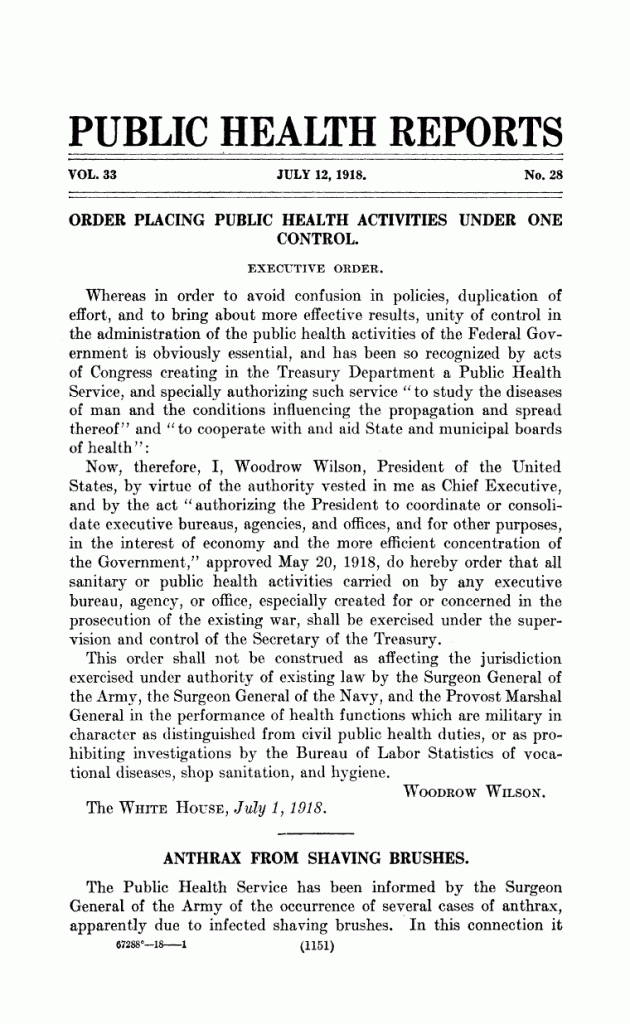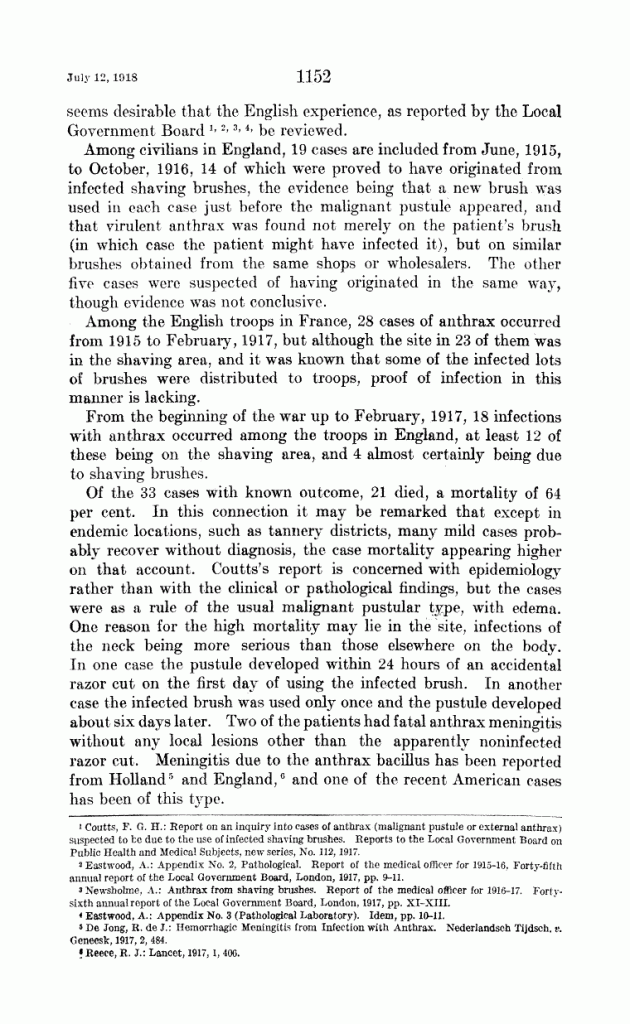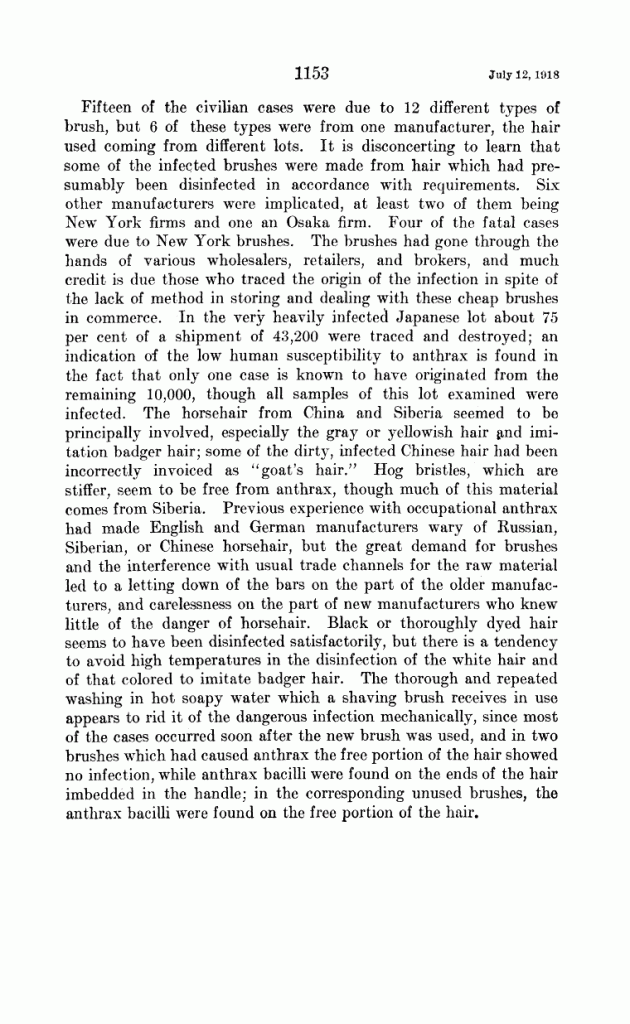Fear, uncertainly and doubt more or less killed of the horse hair shaving brush in the 1920’s. FUD about anthrax from shaving brushes, to be specific. I’ve mentioned the subject before, but it has been a while. So lets revisit the subject with a 103 years old public health report titled – unsurprisingly – “Anthrax from shaving brushes”.
The Public Health Service has been informed by the Surgeon General of the Army of the occurrence of several cases of anthrax, apparently due to infected shaving brushes. In this connection it seems desirable that the English experience, as reported by the Local Government Board be reviewed.
Among civilians in England, 19 cases are included from June, 1915, to October, 1916, 14 of which were proved to have originated from infected shaving brushes, the evidence being that a new brush was used in each case just before the malignant pustule appeared, and that virulent anthrax was found not merely on the patient’s brush (in which case the patient might have infected it), but on similar brushes obtained from the same shops or wholesalers. The other five cases were suspected of having originated in the same way, though evidence was not conclusive.
Among the English troops in France, 28 cases of anthrax occurred from 1915 to February, 1917, but although the site in 23 of them was in the shaving area, and it was known that some of the infected lots of brushes were distributed to troops, proof of infection in this manner is lacking.
From the beginning of the war up to February, 1917, 18 infections with anthrax occurred among the troops in England, at least 12 of these being on the shaving area, and 4 almost certainly being due to shaving brushes.
Of the 33 cases with known outcome, 21 died, a mortality of 64 per cent. In this connection it may be remarked that except in endemic locations, such as tannery districts, many mild cases probably recover without diagnosis, the case mortality appearing higher on that account. Coutts’s report is concerned with epidemiology rather than with the clinical or pathological findings, but the cases were as a rule of the usual malignant pustular type, with edema. One reason for the high mortality may lie in the site, infections of the neck being more serious than those elsewhere on the body. In one case the pustule developed within 24 hours of an accidental razor cut on the first day of using the infected brush. In another case the infected brush was used only once and the pustule developed about six days later. Two of the patients had fatal anthrax meningitis without any local lesions other than the apparently noninfected razor cut. Meningitis due to the anthrax bacillus has been reported from Holland’ and England,6 and one of the recent American cases has been of this type.
Fifteen of the civilian cases were due to 12 different types of brush, but 6 of these types were from one manufacturer, the hair used coming from different lots. It is disconcerting to learn that some of the infected brushes were made from hair which had presumably been disinfected in accordance with requirements. Six other manufacturers were implicated, at least two of them being New York firms and one an Osaka firm. Four of the fatal cases were due to New York brushes. The brushes had gone through the hands of various wholesalers, retailers, and brokers, and much credit is due those who traced the origin of the infection in spite of the lack of method in storing and dealing with these cheap brushes in commerce. In the very heavily infected Japanese lot about 75 per cent of a shipment of 43,200 were traced and destroyed; an indication of the low human susceptibility to anthrax is found in the fact that only one case is known to have originated from the remaining 10,000, though all samples of this lot examined were infected. The horsehair from China and Siberia seemed to be principally involved, especially the gray or yellowish hair find imitation badger hair; some of the dirty, infected Chinese hair had been incorrectly invoiced as “goat’s hair.” Hog bristles, which are stiffer, seem to be free from anthrax, though much of this material comes from Siberia. Previous experience with occupational anthrax had made English and German manufacturers wary of Russian, Siberian, or Chinese horsehair, but the great demand for brushes and the interference with usual trade channels for the raw material led to a letting down of the bars on the part of the older manufacturers, and carelessness on the part of new manufacturers who knew little of the danger of horsehair. Black or thoroughly dyed hair seems to have been disinfected satisfactorily, but there is a tendency to avoid high temperatures in the disinfection of the white hair and of that colored to imitate badger hair. The thorough and repeated washing in hot soapy water which a shaving brush receives in use appears to rid it of the dangerous infection mechanically, since most of the cases occurred soon after the new brush was used, and in two brushes which had caused anthrax the free portion of the hair showed no infection, while anthrax bacilli were found on the ends of the hair imbedded in the handle; in the corresponding unused brushes, the anthrax bacilli were found on the free portion of the hair.
The paper, with original typeset and footnote, can be freely downloaded from JSTOR.
I’ve also written about a couple of patents for disposable shaving brushes that sought to mitigate the risk. You can read all about it here and here.




Pingback: Charles E Scott's disposable shaving cup - Wegian WetshavingWegian Wetshaving
Pingback: A more modern shaving cup - Wegian WetshavingWegian Wetshaving
Pingback: Self destroying disposable shaving brush - Wegian WetshavingWegian Wetshaving